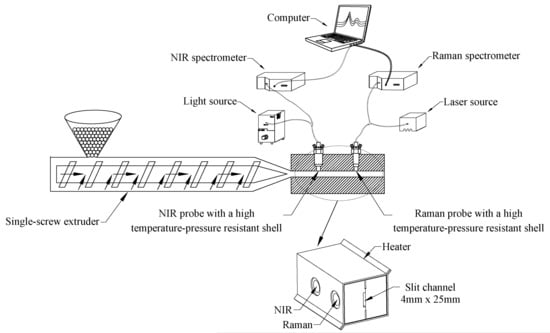Fusion of Near-Infrared and Raman Spectroscopy for In-Line Measurement of Component Content of Molten Polymer Blends
Abstract
1. Introduction
2. Materials and Methods
2.1. Sample Preparation
2.2. In-Line Spectra Collection
2.3. Data Modeling
2.4. Performance of Model
3. Result and Discussion
3.1. Analysis of Spectra
3.2. Comparison of Models
4. Conclusions
Author Contributions
Funding
Conflicts of Interest
References
- Robeson, L.M. Application of Polymer Blends: Emphasis on Recent Advances. Polym. Eng. Sci. 2010, 24, 587–597. [Google Scholar] [CrossRef]
- Spiess, H.W. NMR Methods for Solid Polymers. Annu. Rev. Mater. Res. 1991, 21, 131–158. [Google Scholar] [CrossRef]
- Kamenskii, M.G.; Molchanov, Y.M. application of the method of thermogravimetric analysis fordetermination of the contents of components in organicplastics. Mech. Compos. Mater. 1981, 17, 242–245. [Google Scholar] [CrossRef]
- Baeten, V.; Dardenne, P. Spectroscopy: Developments in instrumentation and analysis. Grasas Y Aceites 2002, 53, 45–63. [Google Scholar] [CrossRef]
- Kong, J.; Yu, S. Fourier transform infrared spectroscopic analysis of protein secondary structures. Acta Biochim. Biophys. Sin. 2007, 39, 549–559. [Google Scholar] [CrossRef] [PubMed]
- Cho, B.K. Spectroscopic Techniques for Nondestructive Quality Inspection of Pharmaceutical Products: A Review. J. Biosyst. Eng. 2015, 40, 394–408. [Google Scholar]
- Teixeira, A.M.; Sousa, C. A review on the application of vibrational spectroscopy to the chemistry of nuts. Food Chem. 2019, 277, 713–724. [Google Scholar] [CrossRef]
- Alig, I.; Fischer, D.; Lellinger, D.; Steinhoff, B. Combination of NIR, Raman, Ultrasonic and Dielectric Spectroscopy for In Line Monitoring of the Extrusion Process. Macromol. Symp. 2005, 230, 51–58. [Google Scholar] [CrossRef]
- Coates, P.D.; Barnes, S.E.; Sibley, M.G.; Brown, E.C.; Edwards, H.G.M.; Scowen, I.J. In-process vibrational spectroscopy and ultrasound measurements in polymer melt extrusion. Polymer 2003, 44, 5937–5949. [Google Scholar] [CrossRef]
- Jr, C.A.C.; Pontier, A.; Durand, J.; Pinto, J.C.; Prat, L. Real time monitoring of the quiescent suspension polymerization of methyl methacrylate in microreactors—Part 1. A kinetic study by Raman spectroscopy and evolution of droplet size. Chem. Eng. Sci. 2015, 131, 340–352. [Google Scholar]
- Brun, N.; Chevrel, M.C.; Falk, L.; Hoppe, S.; Durand, A.; Chapron, D.; Bourson, P. Contribution of Raman Spectroscopy to In Situ Monitoring of a High-Impact Polystyrene Process. Chem. Eng. Technol. 2014, 37, 275–282. [Google Scholar] [CrossRef]
- Reis, M.M.; Araújo, P.H.H.; Sayer, C.; Giudici, R. Evidences of correlation between polymer particle size and Raman scattering. Polymer 2003, 44, 6123–6128. [Google Scholar] [CrossRef]
- Hansen, M.G.; Vedula, S. In-line fiber-optic near-infrared spectroscopy: Monitoring of rheological properties in an extrusion process. Part I. J. Appl. Polym. Sci. 1998, 68, 859–872. [Google Scholar] [CrossRef]
- Batra, J.; Khettry, A.; Hansen, M.G. In-line monitoring of titanium dioxide content in poly (ethylene terephthalate) extrusion. Polym. Eng. Sci. 1994, 34, 1767–1772. [Google Scholar] [CrossRef]
- Dumitrescu, O.R.; Baker, D.C.; Foster, G.M.; Evans, K.E. Near infrared spectroscopy for in-line monitoring during injection moulding. Polym. Test. 2005, 24, 367–375. [Google Scholar] [CrossRef]
- Barnes, S.E.; Sibley, M.G.; Edwards, H.G.M.; Coates, P.D. Process monitoring of polymer melts using in-line spectroscopy. Trans. Inst. Meas. Control. 2007, 29, 453–465. [Google Scholar] [CrossRef]
- Castanedo, F. A review of data fusion techniques. Sci. World J. 2013, 2013, 704504. [Google Scholar] [CrossRef]
- Márquez, C.; López, M.I.; Ruisánchez, I.; Callao, M.P. FT-Raman and NIR spectroscopy data fusion strategy for multivariate qualitative analysis of food fraud. Talanta 2016, 161, 80–86. [Google Scholar] [CrossRef]
- Dearing, T.I.; Thompson, W.J.; Rechsteiner, C.E.; Marquardt, B.J. Characterization of Crude Oil Products Using Data Fusion of Process Raman, Infrared, and Nuclear Magnetic Resonance (NMR) Spectra. Appl. Spectrosc. 2011, 65, 181–186. [Google Scholar] [CrossRef]
- Comino, F.; Ayora-Cañada, M.J.; Aranda, V.; Díaz, A.; Domínguez-Vidal, A. Near-infrared spectroscopy and X-ray fluorescence data fusion for olive leaf analysis and crop nutritional status determination. Talanta 2018, 188, 676–684. [Google Scholar] [CrossRef]
- Huang, G.B.; Zhu, Q.Y.; Siew, C.K. Extreme learning machine: Theory and applications. Neurocomputing 2006, 70, 489–501. [Google Scholar] [CrossRef]
- Rinnan, Å.; Berg, F.V.D.; Engelsen, S.B. Review of the most common pre-processing techniques for near-infrared spectra. Trends Anal. Chem. 2009, 28, 1201–1222. [Google Scholar] [CrossRef]
- Mirchandani, G.; Cao, W. On hidden nodes for neural nets. IEEE Trans. Circuits Syst. 1989, 36, 661–664. [Google Scholar] [CrossRef]
- Workman, J. Practical Guide to Interpretive Near-Infrared Spectroscopy; CRC Press: Boca Raton, FL, USA, 2007. [Google Scholar]
- Dong, K.; Rao, Z.F.; Yang, X.Y.; Lin, J.C.; Zhang, P.X. Determination of Several Plastic by Raman Spectroscopy. China Plast. Ind. 2011, 39, 67–70. [Google Scholar]
- Bro, R.; Smilde, A.K. Principal component analysis. Anal. Methods 2014, 6, 2812–2831. [Google Scholar] [CrossRef]
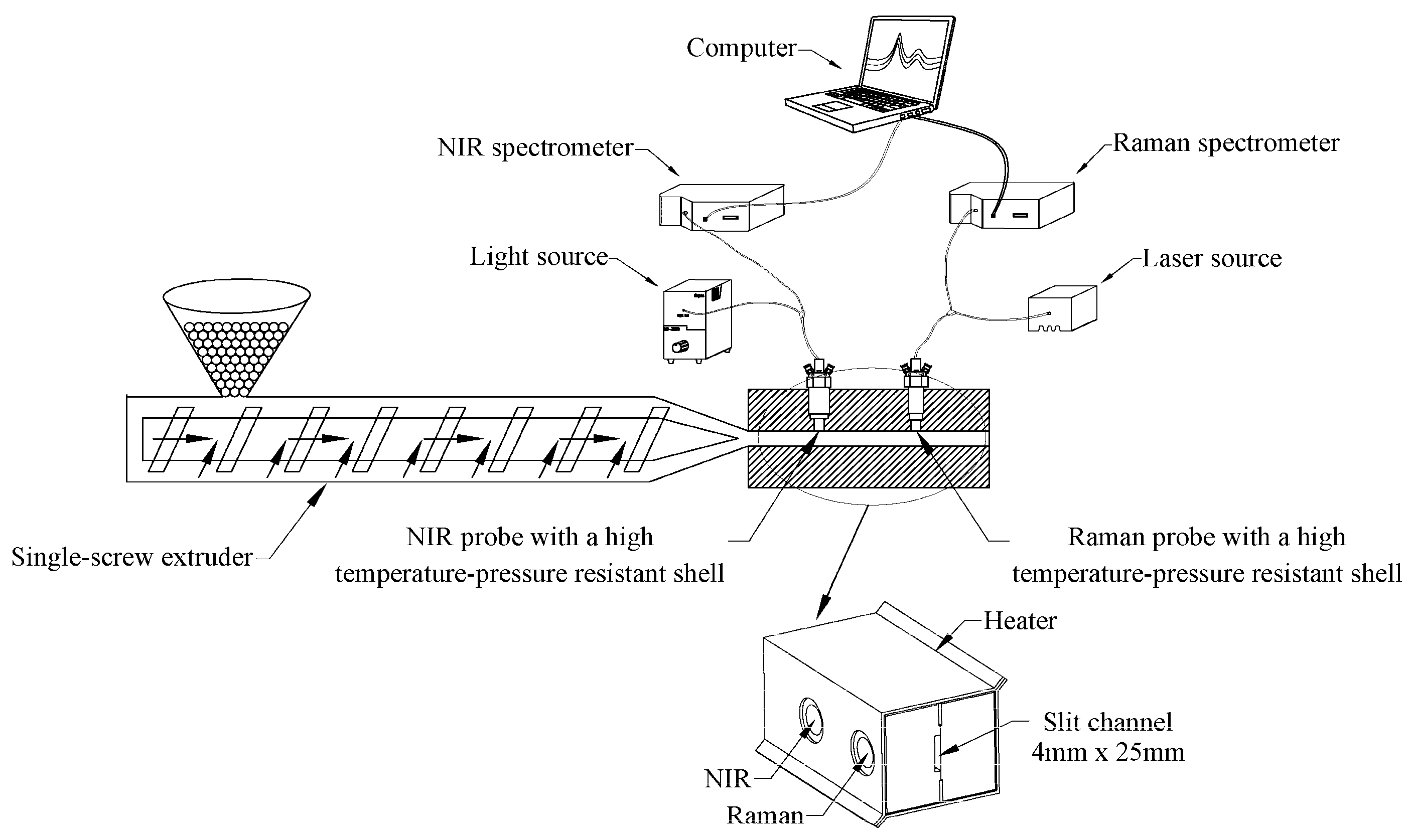
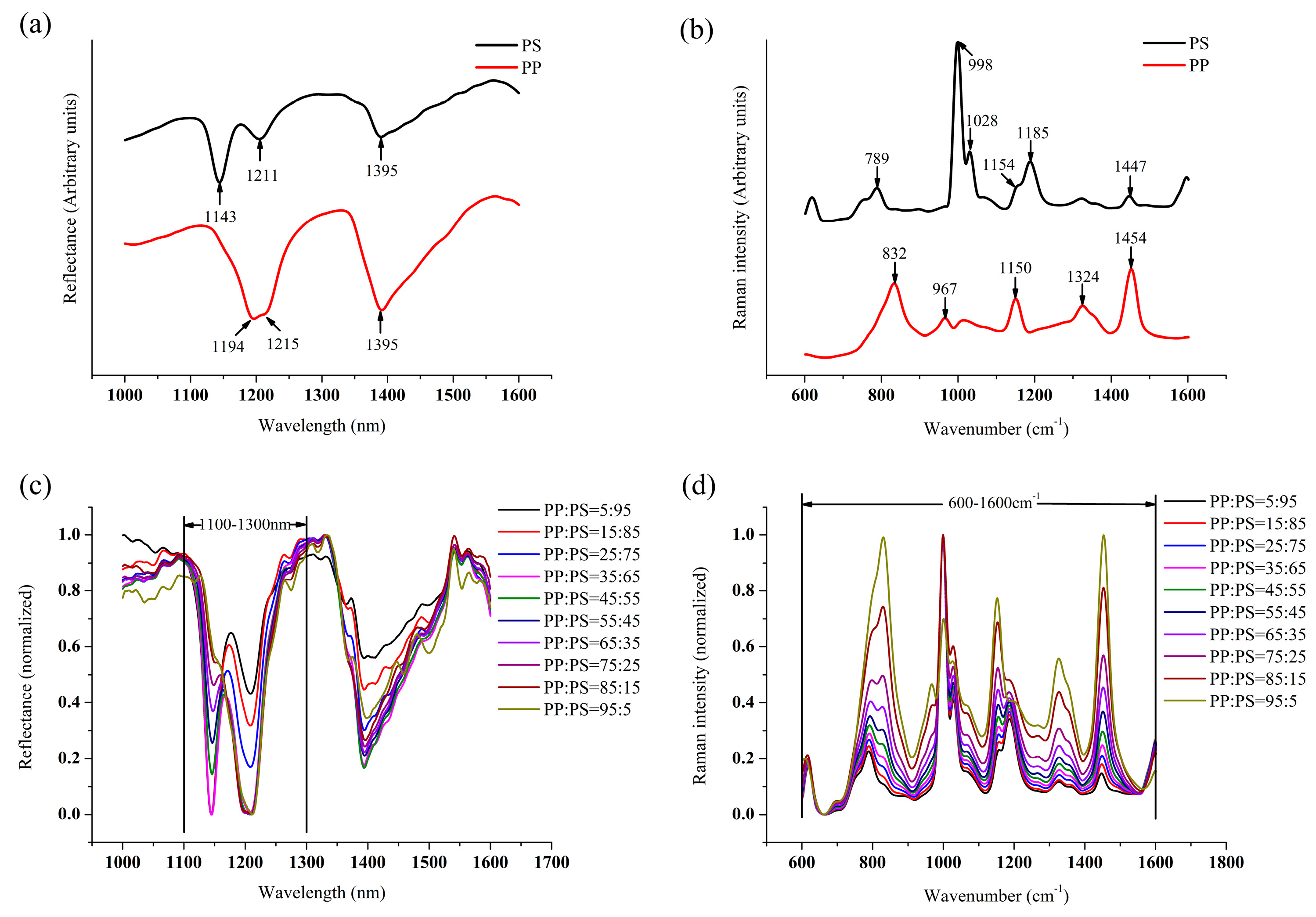
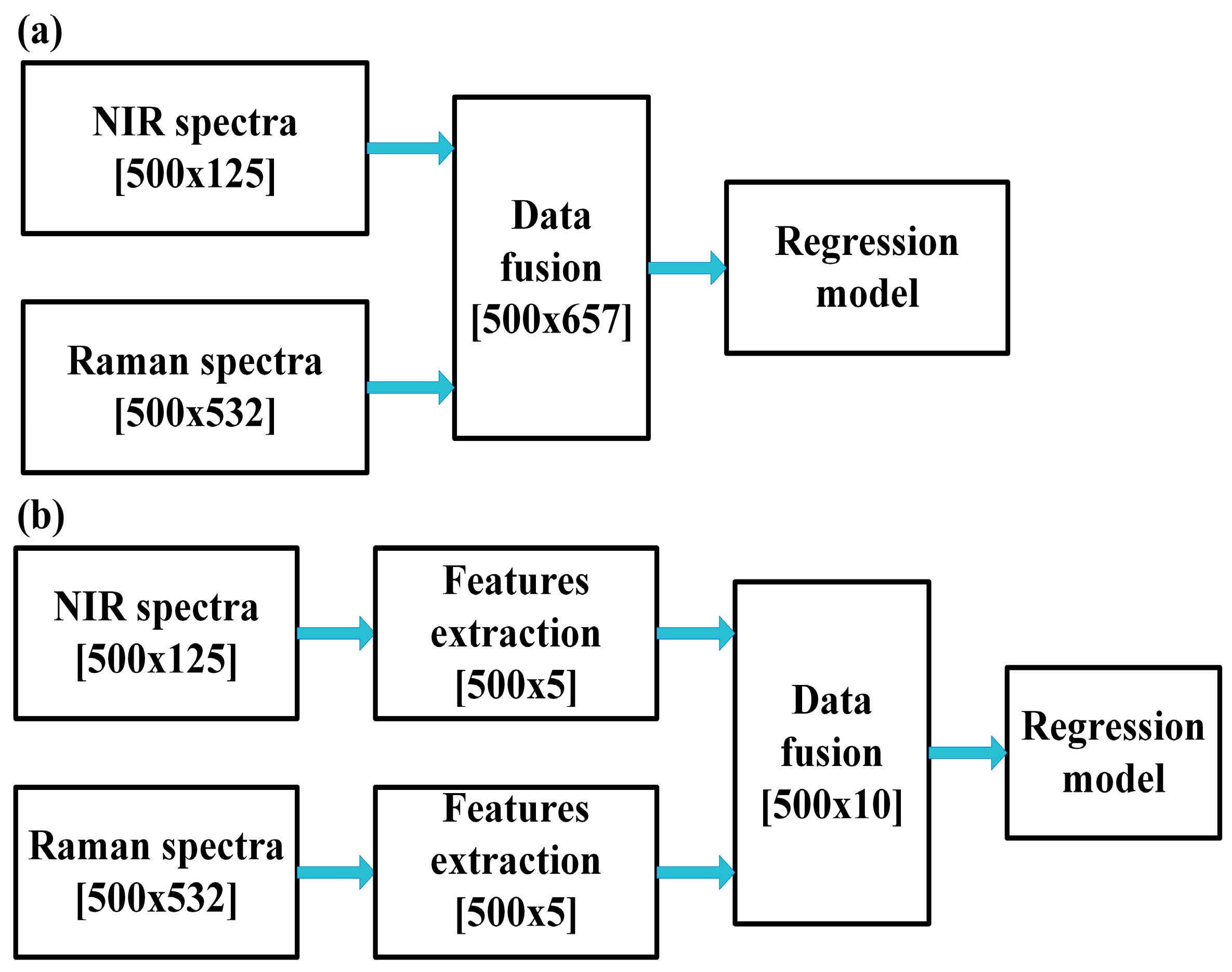

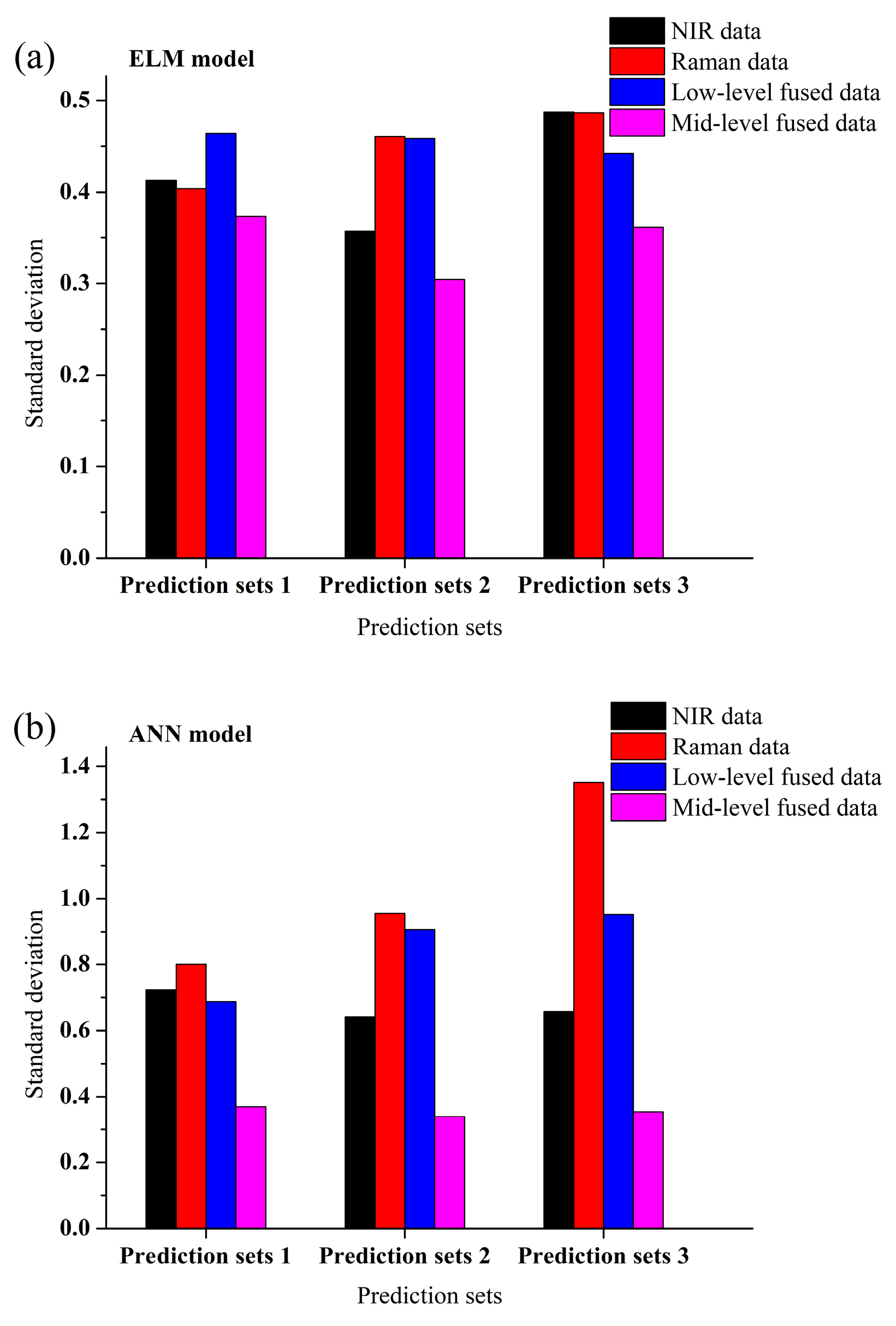
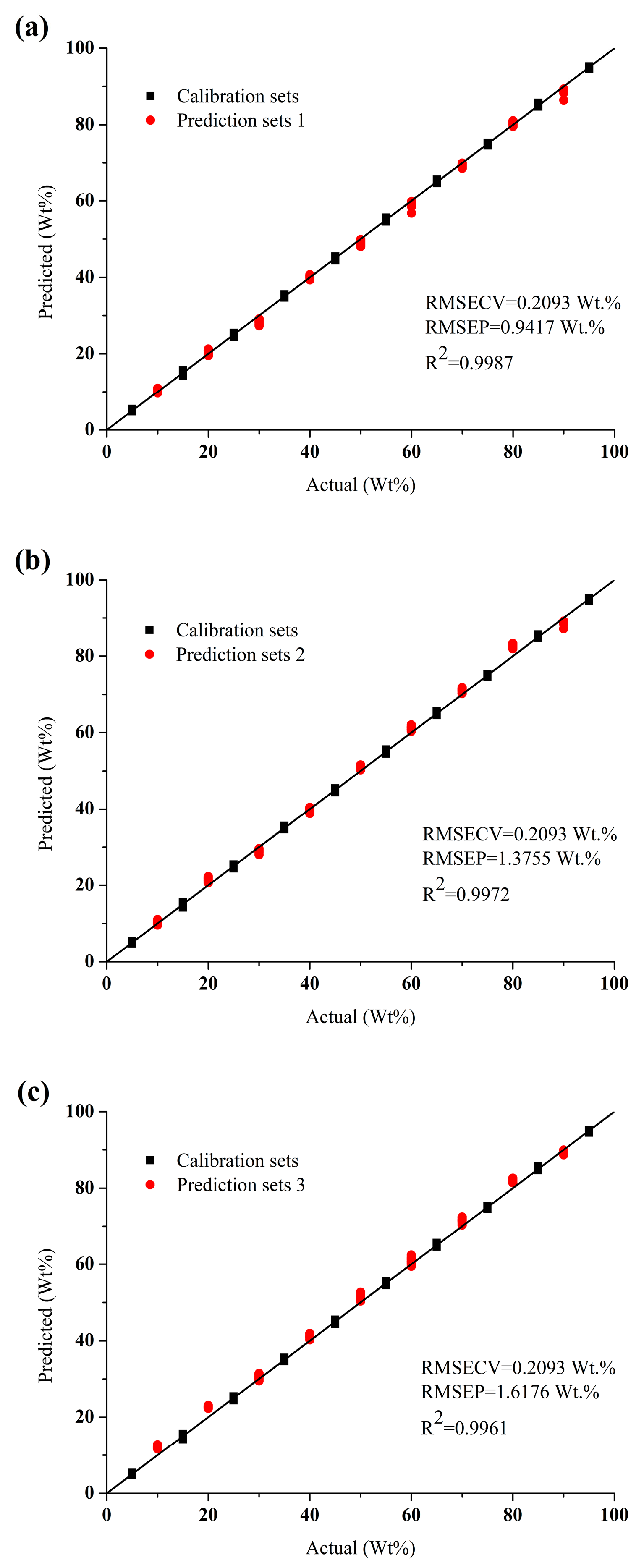
| Material | Grades | Density (g/cm3) | Melt Flow Index (g/10 min) |
|---|---|---|---|
| PP | EP548R-Basell | 0.905 | 21 |
| HP741T-Basell | 0.9 | 60 | |
| 7033N-Exxon Mobil | 0.9 | 8 | |
| PS | 158K-BASF | 1.05 | 3.15 |
| PG33-QIMEI | 1.05 | 8 |
| Sets | Grades | PP Contents |
|---|---|---|
| Calibration sets | PP-EP548R/PS-158K | From 95 to 5 wt. % at 10 wt. % intervals |
| Prediction sets 1 | PP-EP548R/PS-158K | From 90 to 10 wt. % at 10 wt. % intervals |
| Prediction sets 2 | PP-HP741T/PS-158K | From 90 to 10 wt. % at 10 wt. % intervals |
| Prediction sets 3 | PP-7033N/PS-PG33 | From 90 to 10 wt. % at 10 wt. % intervals |
| Component | NIR Band (nm) | Assignment | Raman Band (cm−1) | Assignment |
|---|---|---|---|---|
| PP | 1194 | Methyl C-H | 1454 | -CH2- scissoring |
| 1215/1395 | Methylene C-H | 1324 | -CH2- twisting | |
| 1150 | C-C skeleton stretching | |||
| 967/832 | -CH3 rocking | |||
| PS | 1143 | Aromatic C-H | 1447 | -CH- asymmetric bending |
| 1211/1395 | Methylene C-H | 1185 | C-Ph asymmetric stretching | |
| 1154/789 | C-Ph asymmetric stretching | |||
| 1028 | C-C asymmetric stretching in the benzene ring | |||
| 998 | Benzene ring breathing |
| Data Source | Sets | PLS Model | ANN Model | ELM Model | |||
|---|---|---|---|---|---|---|---|
| R2 | RMSEP/wt.% | R2 | RMSEP/wt.% | R2 | RMSEP/wt.% | ||
| NIR spectra | Prediction set 1 | 0.9916 (11) a | 2.3725 | 0.9978 (9) | 1.2211 | 0.9984 (99) | 1.0241 |
| Prediction set 2 | 0.9858 (11) | 3.0795 | 0.9916 (9) | 2.3819 | 0.9928 (99) | 2.1863 | |
| Prediction set 3 | 0.9904 (11) | 2.5311 | 0.9794 (9) | 3.5072 | 0.9854 (99) | 3.1249 | |
| Raman spectra | Prediction set 1 | 0.8335 (5) | 10.5365 | 0.9954 (9) | 1.6918 | 0.9986 (78) | 0.9789 |
| Prediction set 2 | 0.0049 (5) | 25.7559 | 0.9836 (9) | 3.1308 | 0.9917 (78) | 2.3571 | |
| Prediction set 3 | 0.7095 (5) | 13.9166 | 0.9929 (9) | 2.2324 | 0.9974 (78) | 1.3133 | |
| Low-level fused data | Prediction set 1 | 0.9963 (8) | 1.6011 | 0.9983 (9) | 1.0877 | 0.9994 (124) | 0.6583 |
| Prediction set 2 | 0.9939 (8) | 2.0200 | 0.9973 (9) | 1.2911 | 0.9986 (124) | 0.9507 | |
| Prediction set 3 | 0.9607 (8) | 5.1196 | 0.9946 (9) | 1.8388 | 0.9955 (124) | 1.7408 | |
| Mid-level fused data | Prediction set 1 | 0.9945 (9) | 1.9159 | 0.9987 (9) | 0.9417 | 0.9985 (47) | 0.9923 |
| Prediction set 2 | 0.9909 (9) | 2.4595 | 0.9972 (9) | 1.3755 | 0.9970 (47) | 1.4142 | |
| Prediction set 3 | 0.9554 (9) | 5.4502 | 0.9961 (9) | 1.6176 | 0.9958 (47) | 1.6803 | |
© 2019 by the authors. Licensee MDPI, Basel, Switzerland. This article is an open access article distributed under the terms and conditions of the Creative Commons Attribution (CC BY) license (http://creativecommons.org/licenses/by/4.0/).
Share and Cite
Zhu, S.; Song, Z.; Shi, S.; Wang, M.; Jin, G. Fusion of Near-Infrared and Raman Spectroscopy for In-Line Measurement of Component Content of Molten Polymer Blends. Sensors 2019, 19, 3463. https://doi.org/10.3390/s19163463
Zhu S, Song Z, Shi S, Wang M, Jin G. Fusion of Near-Infrared and Raman Spectroscopy for In-Line Measurement of Component Content of Molten Polymer Blends. Sensors. 2019; 19(16):3463. https://doi.org/10.3390/s19163463
Chicago/Turabian StyleZhu, Shichao, Zhuoming Song, Shengyu Shi, Mengmeng Wang, and Gang Jin. 2019. "Fusion of Near-Infrared and Raman Spectroscopy for In-Line Measurement of Component Content of Molten Polymer Blends" Sensors 19, no. 16: 3463. https://doi.org/10.3390/s19163463
APA StyleZhu, S., Song, Z., Shi, S., Wang, M., & Jin, G. (2019). Fusion of Near-Infrared and Raman Spectroscopy for In-Line Measurement of Component Content of Molten Polymer Blends. Sensors, 19(16), 3463. https://doi.org/10.3390/s19163463




